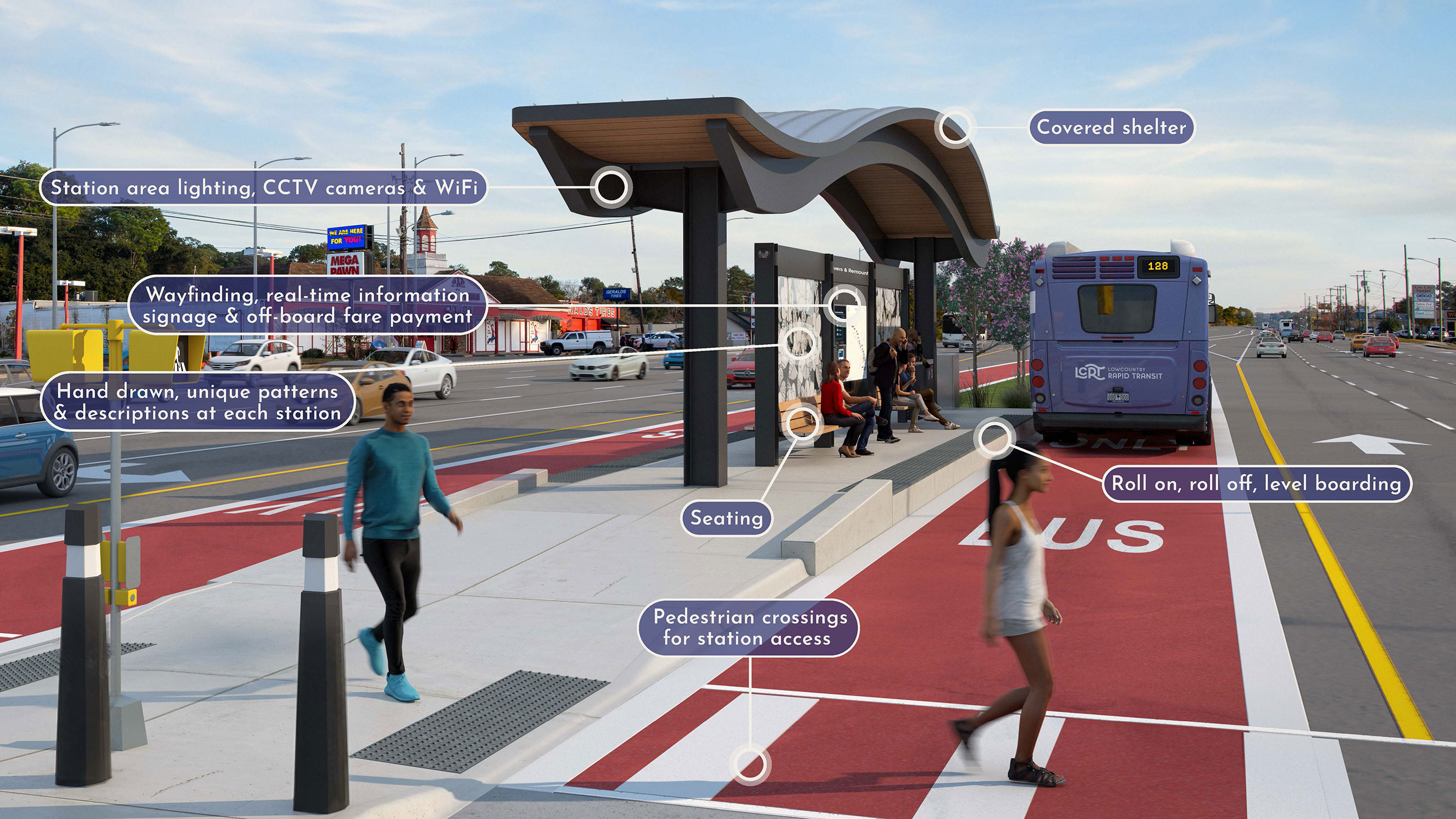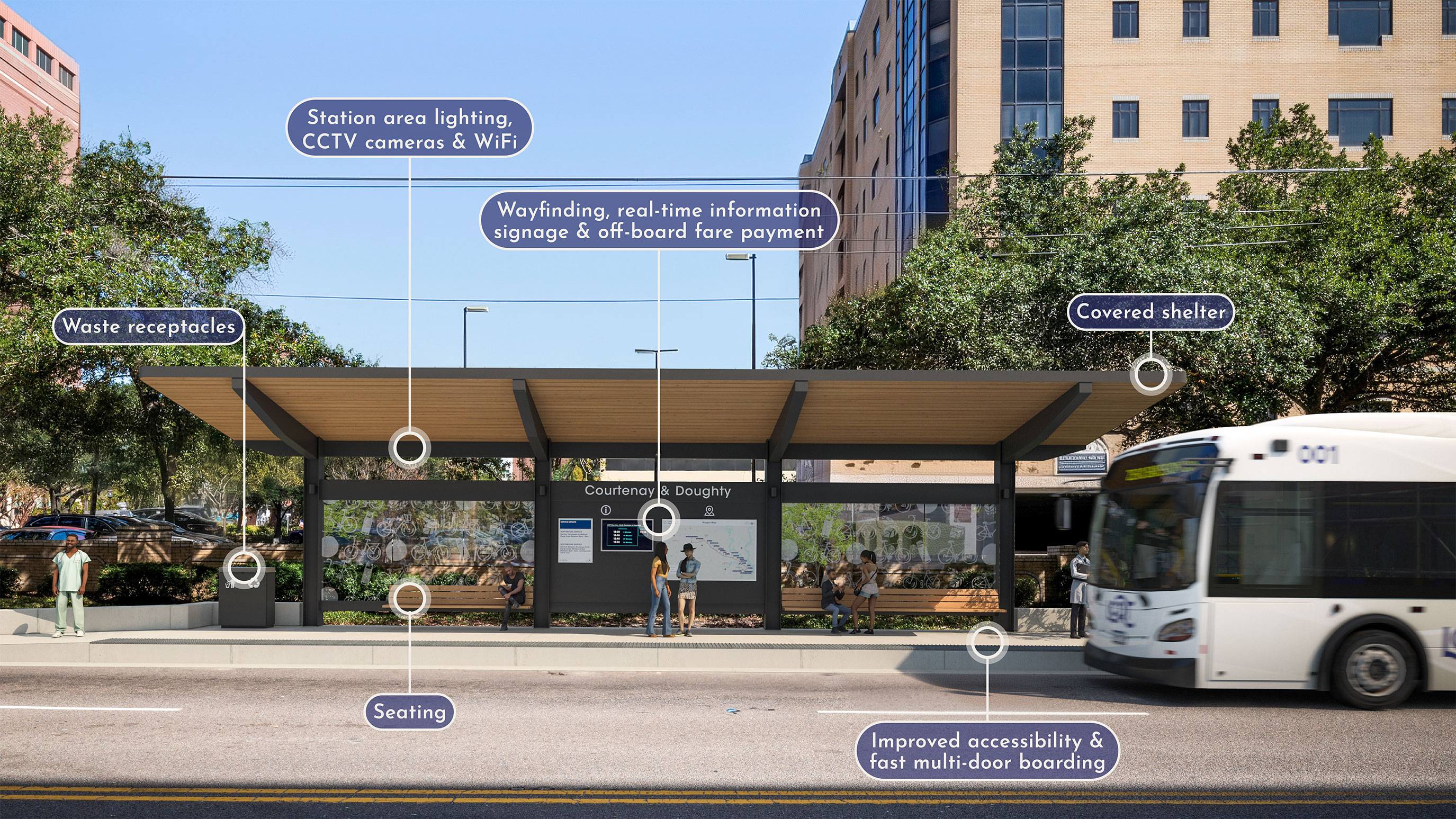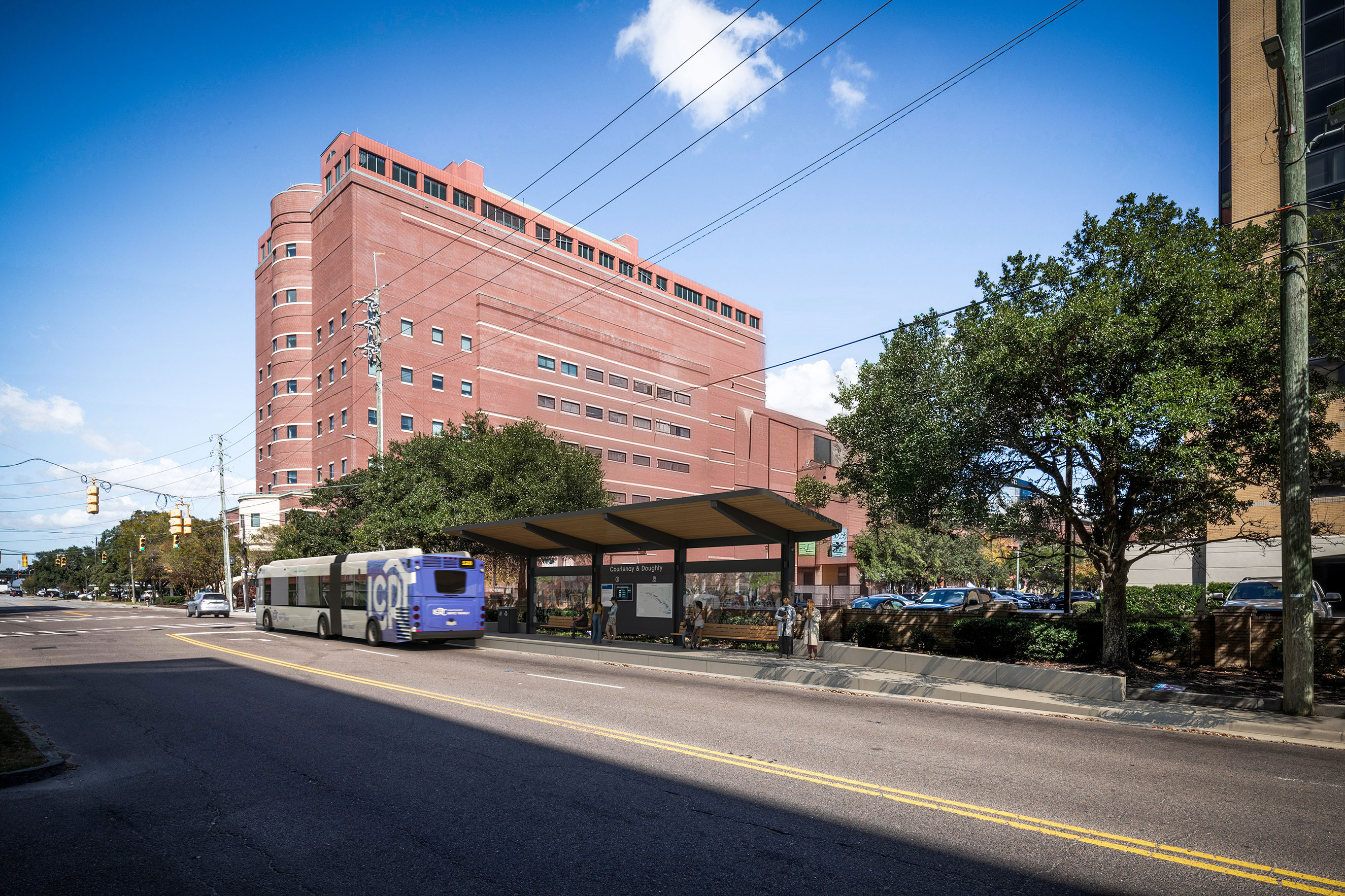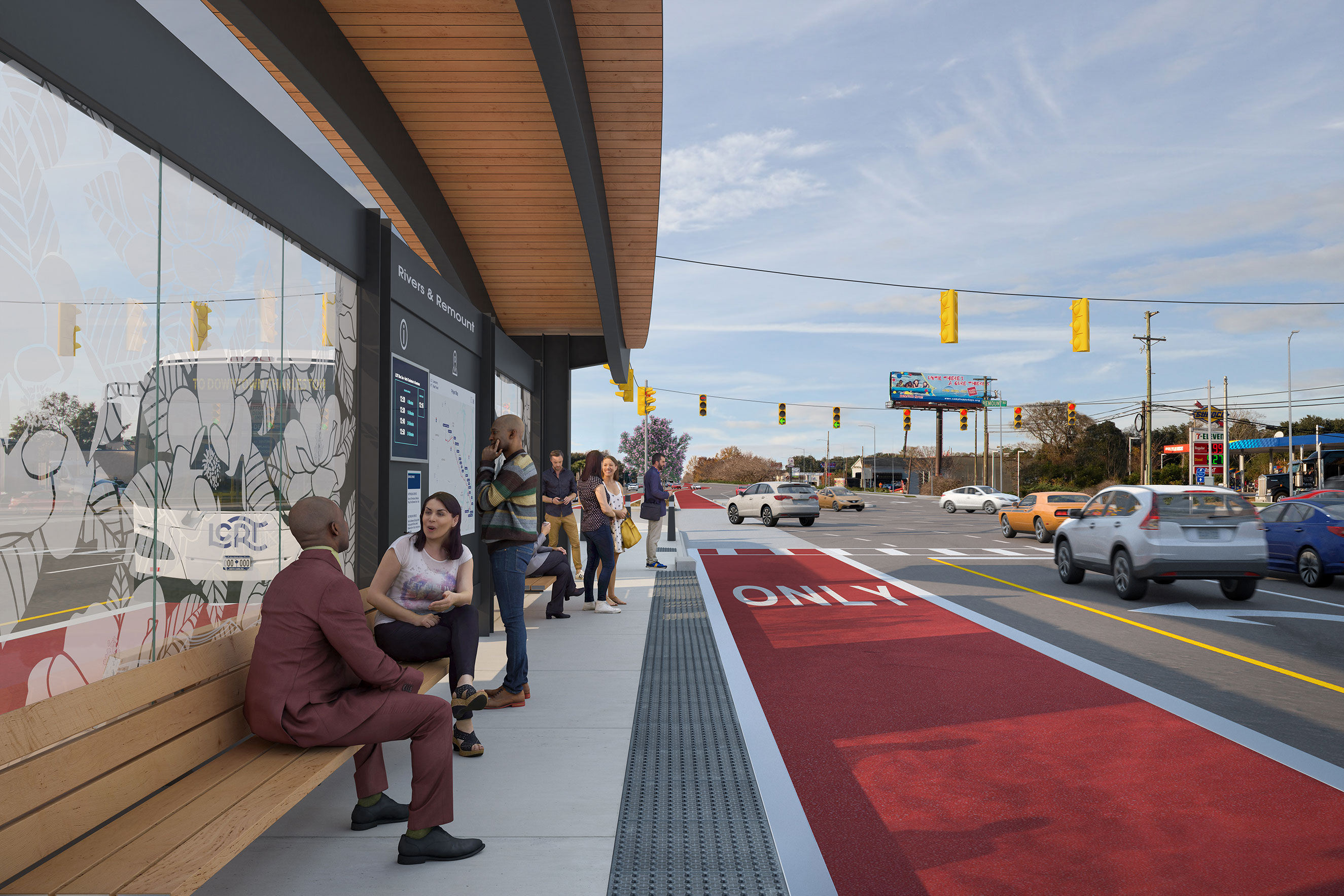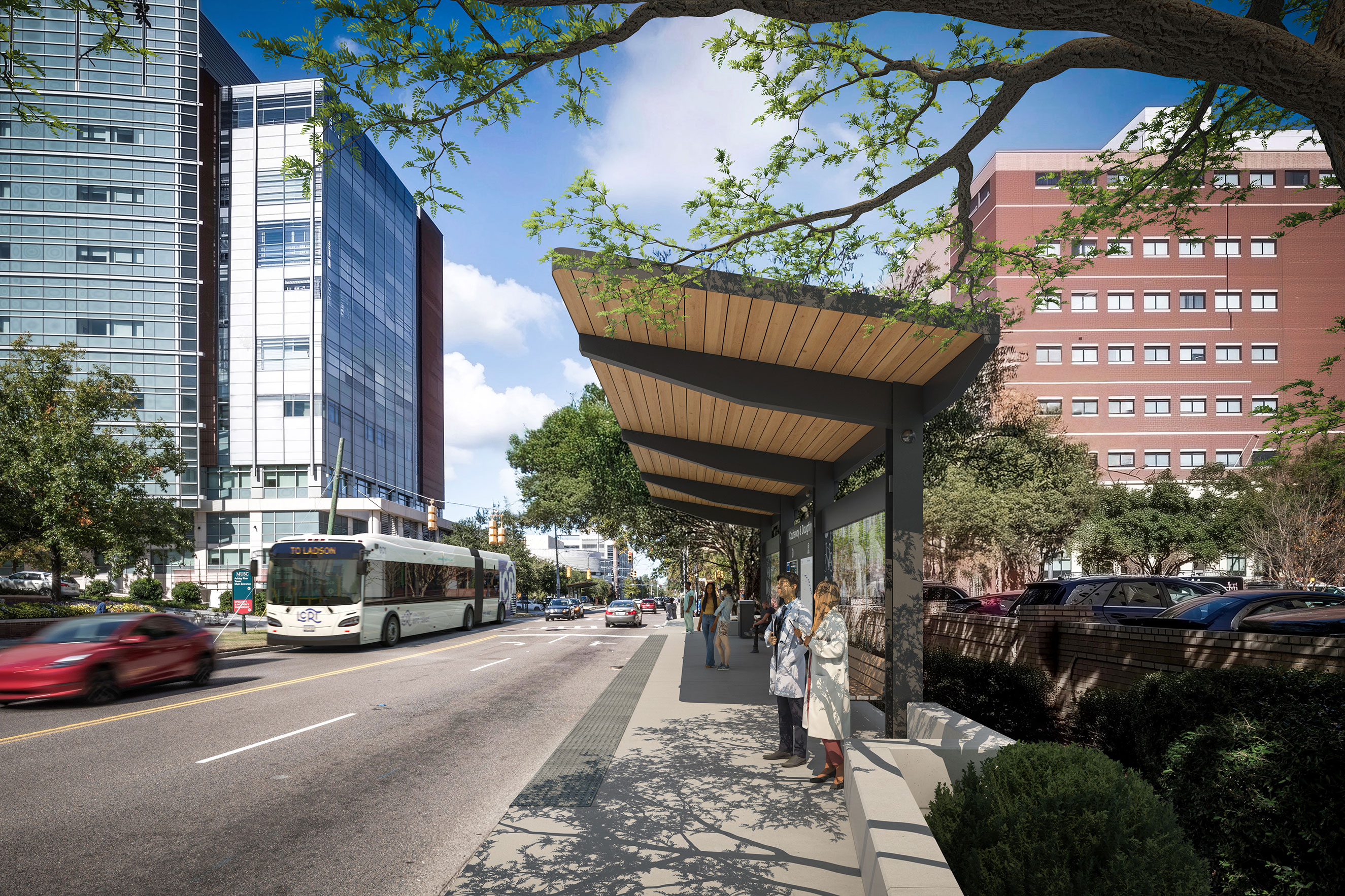Project Overview
Lowcountry Rapid Transit (LCRT) is a 21.3-mile modern bus rapid transit system that will transform our region by improving transportation for people traveling on buses, on foot, and on bikes. The foundation of LCRT will serve Charleston, North Charleston, and Ladson, and spark upward mobility and economic growth through the area.
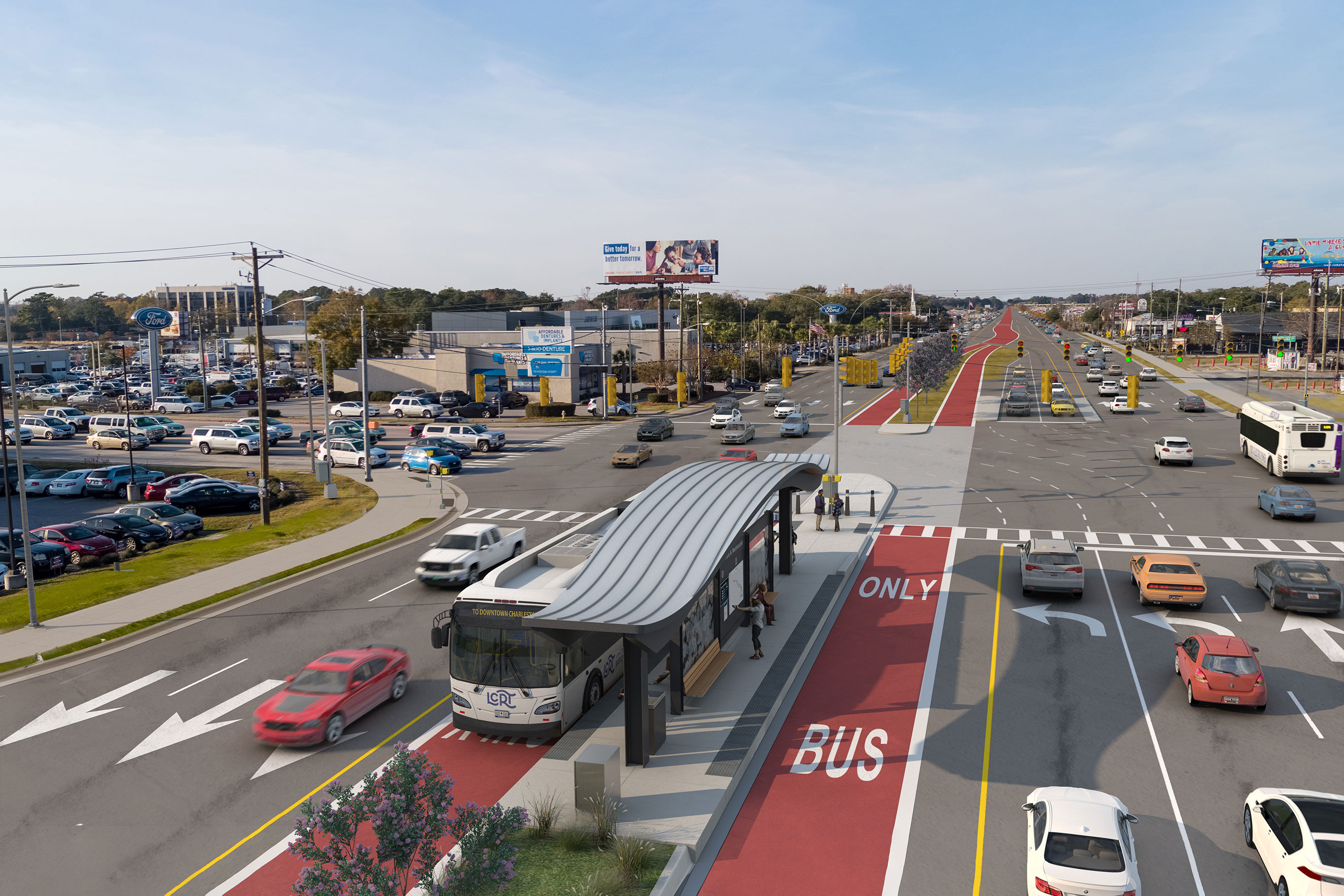
Project Highlights
-
21 hours of weekday service with 10-minute peak service frequency
-
20 modern stations
-
Dedicated 60-foot articulated vehicles will serve more than 7,600 daily riders on the line
-
Roadway improvements and added infrastructure to bring safer, more efficient travel for all commuters
-
Advanced technology to make the system more reliable and comfortable, including:
- Stoplight signal priority and synchronization
- Wi-Fi equipped stations
- Updated wayfinding and corridor lighting
- Off-board fare payment
-
Sidewalk and shared-use path connectivity from CSU to downtown and 34 new signalized pedestrian crosswalks to support safe bicycle and pedestrian mobility
Project Schedule
Since 2019, the LCRT project team has followed the Federal Transit Administration's (FTA) Capital Investment Grants (CIG) program that consists of set, federally mandated phases and requires a clearly defined schedule.
The project team continues to follow this process and has made great progress to advance the project's design. The Engineering phase will consist of final design over the next two years, and construction is anticipated to begin in 2027.
As the project team finalizes the system's design, we are also being thoughtful about minimizing construction impacts down the road. We are actively coordinating with other projects in the area about construction timing and impacts.
See the project timeline below for more details.
-
Pre-Project Development, Operational Analysis, Alternative Analysis, Travel Demand Forecasting
Local Planning
Completed 2016 -
Preferred Alternative Identified, Agency Coordination, Scoping and NEPA, Funding and Schedule, Existing Conditions Evaluation, Conceptual Design (10%)
Project Programming
Completed 2019 -
Complete NEPA, Complete 30% Design, Adapt a Locally Preferred Alternative, Refine Project Schedule and Budget, Financial Plan, FTA Rating and Readiness Review
Project Development
Completed 2022 -
Complete Design and Engineering, FTA Rating and Readiness Evaluation, Full Funding Grant Agreement
Engineering
We Are Here! -
Construction Procurement, Construction, Standard Operating Procedures, Systems Testing, Safety Certification, Operations Training, System Opening
Construction
Est. 2027-2029
Project timeline is estimated under the New Starts CIG program guidelines and is subject to change.
Engaging with Our Communities
Our community has remained at the center of the LCRT project. This system is being built for the community, by the community, and our project team remains committed to engaging cross-sectionally and with the public, neighborhoods, and businesses to provide input on the project.
The feedback and input we have received over the years has directly informed the system's progress and design. Check out how we've engaged to date:
- 4 Stakeholder Committees
- 180+ Stakeholder Meetings
- 1,500+ Events and Touch Points wth Local Communities, Organizations and Businesses
- 66,000 Direct Mailings
- 1,500+ Comments Received
- 3,700+ People on our Email List
- 30+ E-Newsletters Delivered
- 6,500+ Social Media Followers
- 4 Rounds of Public and Virtual Meetings
- 124,000+ Website Visitors

Visualization
It's more than a transit system — it's our connection to us.
Since the initiation of LCRT, the project team has aimed to keep the Lowcountry's communities, lifestyle, and essence at the center of our work. We recognize that this region's rich culture and history, beautiful nature and wildlife, vibrant culinary scene, plentiful outdoor activities – and most of all, it's people – are what make the Lowcountry an incredible place to live, work, and play.
Watch the video to see how our design decisions for this project, made with your feedback in hand, will come to life.
Station Design Features
LCRT will include enhanced stations equipped with key features to provide a comfortable, safe, and accessible experience for passengers. Dive in here to view these station elements.
This is an example of North Charleston station architecture. Read the callouts to learn more about key station features.
Click image to enlarge
The LCRT Route
Each station along the LCRT corridor has been named after the nearest cross street to make navigation easy for both local riders and visitors.
Explore this route in detail on our interactive map on the next slide.
Stops along the Lowcountry Rapid Transit Route southbound:
- US-78 & Commerce Center - proposed Station with Park & Ride
- University & BUC Club
- Rivers & Melnick - Station with Park & Ride
- Rivers & Eagle Landing
- Rivers & Mabeline
- Rivers & Hanahan
- Rivers & Remount
- Rivers & Mall
- Rivers and Durant (future station)
- Rivers & Helm
- Rivers & Dorchester
- Rivers & Reynolds
- King & Hackemann
- King & Hagood
- Meeting & Mount Pleasant - Park & Ride to be added in future project
- Meeting & Lee
- Meeting & John
- Calhoun & Coming
- Calhoun & Jonathan Lucas
- Courtenay & Doughty
- Line & Westedge
There will be a dedicated bus lane between the University & BUC Club stop and the Rivers & Reynolds stop.
Explore the Corridor
The LCRT project reached its 60% design milestone this fall and has now entered final design! The 60% design plans outline more specific details about LCRT's design, like its construction footprint, station branding and architecture details, bike and pedestrian accommodations, and intersection and roadway designs. Explore the interactive map below to see how the system has been refined through 60% design details.
How to navigate the map:
- Zoom along the route using your mouse or the +/- buttons.
- Use the legend below to help you as you navigate through the map.
- Click on the icons, pins, and pink & orange lines to learn more about different project design elements, such as station locations, new pedestrian crossings, dedicated lane configurations, traffic signal priority, new sidewalks and shared-use paths, and more.
- The LCRT route is shown in aqua blue.
- Other design elements shown include station locations, new pedestrian crossings, dedicated lane configurations, traffic signal priority, new sidewalks and shared-use paths, key points and more.
- Travel lanes are shown in gray, dedicated lanes are shown in red, stations are shown in blue, and grass medians are shown in green.
- LCRT Route
-
 Planned Station Locations
Planned Station Locations
-
 Future Station Locations
Future Station Locations
-
 New Pedestrian Crosswalk
New Pedestrian Crosswalk
-
 BRT Lane Configurations
BRT Lane Configurations
-
 Transit Signal Locations
Transit Signal Locations
-
 Shipwatch Station
Shipwatch Station
-
 CARTA HOP Lot
CARTA HOP Lot
-
 New Sidewalks
New Sidewalks
- New Sidewalks
-
 New Shared-Use Paths
New Shared-Use Paths
- New Shared-Use Paths
- LCRT 60% Design
- LCRT Bus Lanes
- LCRT Bus Stations
- Vehicle Travel Lanes
Frequently Asked Questions
View the questions below to learn the answers to key questions about the LCRT system. Visit our website for additional FAQs and more information on LCRT.
A traditional bus operates in regular lanes, stops every few blocks and usually has a sign and a bench at stops. BRT operates in transit-only lanes, stops every half mile, utilizes advanced technologies, and offers enhanced stations with more amenities.
Advanced technologies will make the LCRT system faster and more efficient. Technology utilized in LCRT will include traffic signal priority at stoplights, WiFi equipped stations and buses, digital station displays with real-time information and maps, updated wayfinding and corridor lighting, and off-board fare payment. To see some of the technology features, visit the Project Features page of our website.
LCRT will expand access to jobs, affordable housing, education, and community resources. It will provide a new means of transportation and lead to upward mobility and economic growth in the region.
The right-of-way (ROW) process for LCRT began in summer 2024. Those with property impacts will be contacted directly by a ROW agent on behalf of SCDOT. You can learn more about the ROW process in SCDOT's Highways and You resource document or ROW explanation video.
Possibly. BCDCOG has identified a network of potential bus rapid transit corridors. Among them are US Hwy 52 to Moncks Corner and Dorchester Road. In addition, the BCDCOG completed a study to identify a long-range vision for mass transit throughout the region. LCRT is the first of several proposed mass transit lines to serve the region. Read more about the Regional Transit Framework Plan.
Next Steps
Thank you for taking the time to view this online meeting! We look forward to more future touchpoints with you – our communities, stakeholders, and neighborhoods – and to delivering on the promise that brings high quality, affordable, and accessible bus rapid transit to our region.
Our project team is excited to continue working to develop LCRT's final design and construction plans over the coming years. As we continue advancing the project toward construction, our commitment to a community-first project will remain.
Stay Involved
Follow us on social media or sign up for our newsletter on the homepage of our website to stay up to date on project happenings.
Leave a Comment
Thank you for your message!
If you'd like to provide your input on the project or any of the information you viewed in this meeting, please fill out the form below. Comments will be accepted from November 22 - December 16, 2024. Fields marked with a red asterisk (*) are required.


